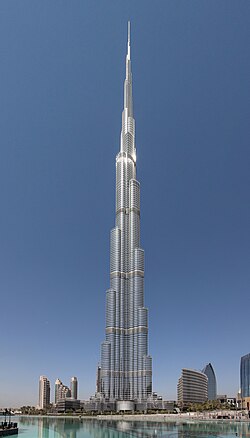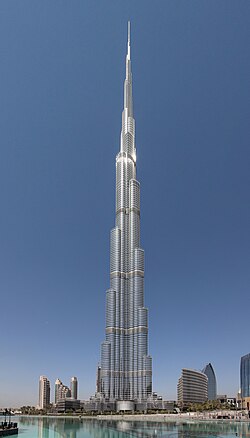The Burj Khalifa in Dubai stands as a testament to human ingenuity, ambition, and architectural excellence.
Soaring to a height of 828 meters (2,717 feet), it holds the title of the world’s tallest building. But behind this monumental achievement lies the vision and expertise of one man: Adrian Smith.
🏙️ The Visionary: Adrian Smith
Early Life and Education
Adrian Devaun Smith was born on August 19, 1944, in Chicago, Illinois. From a young age, he exhibited a keen interest in art and design.
Encouraged by his mother, Smith pursued a Bachelor of Architecture degree from the University of Illinois at Chicago, graduating in 1969.
His academic background laid the foundation for a career that would redefine skylines across the globe.

Career Beginnings
After completing his education, Smith joined the renowned architectural firm Skidmore, Owings & Merrill (SOM) in Chicago.
At SOM, he honed his skills and contributed to several significant projects, including the design of the Jin Mao Tower in Shanghai and the Trump International Hotel & Tower in Chicago.
His work at SOM earned him recognition as a leading architect in the field of supertall buildings.
Founding Adrian Smith + Gordon Gill Architecture
In 2006, Smith left SOM to establish his own architectural firm, Adrian Smith + Gordon Gill Architecture (AS+GG), based in Chicago.
The firm focuses on high-performance, energy-efficient, and sustainable architecture, with a portfolio that includes some of the world’s most iconic structures.
Smith’s vision for AS+GG was to push the boundaries of architectural design while prioritizing environmental responsibility.
🏗️ Designing the Burj Khalifa
The Genesis of the Project
The journey to the Burj Khalifa began in the early 2000s when Emaar Properties, a Dubai-based real estate development company, sought to create a landmark that would symbolize Dubai’s rapid growth and global aspirations.
They approached SOM to design a tower that would surpass all existing skyscrapers in height. Adrian Smith, then a partner at SOM, led the design team.
Architectural Inspiration
The design of the Burj Khalifa draws inspiration from Islamic architecture, particularly the pattern of the desert flower, the Spider Lily.
This influence is evident in the tower’s triple-lobed footprint, which tapers as it ascends, creating a spiraling effect.
This design not only gives the building its distinctive silhouette but also serves functional purposes, such as reducing wind forces and enhancing structural stability.
Structural Innovation
One of the most significant challenges in designing the Burj Khalifa was addressing the forces exerted by wind at such unprecedented heights.
To mitigate these forces, Smith and his team employed a bundled tube design, a structural system that had been pioneered by engineer Fazlur Rahman Khan.
This system allowed for a reduction in the amount of steel used in construction while maintaining the building’s stability.
Construction Challenges
The construction of the Burj Khalifa presented numerous challenges, from the extreme height to the harsh desert environment.
Innovative construction techniques were employed, including the use of high-strength concrete and a unique pumping method to pour concrete at great heights.
The project’s success was a testament to the collaboration between architects, engineers, and construction teams.
🌍 Legacy and Impact
Architectural Influence
The Burj Khalifa has set new standards in architectural design and engineering. Its innovative use of materials, structural systems, and design principles has influenced the design of subsequent supertall buildings worldwide.
The tower’s success has demonstrated that with visionary design and advanced engineering, the sky is the limit.
Cultural Significance
Beyond its architectural achievements, the Burj Khalifa has become a symbol of Dubai’s ambition and modernization.
It attracts millions of visitors annually and serves as a venue for cultural events, including the city’s famous New Year’s Eve fireworks display.
The tower has also been featured in numerous films and media, further cementing its status as a global icon.
Environmental Considerations
In line with Smith’s commitment to sustainability, the Burj Khalifa incorporates several environmentally friendly features.
These include energy-efficient lighting, water recycling systems, and the use of sustainable materials. The building’s design also maximizes natural ventilation, reducing the need for artificial cooling.
Check out other blog- Japanese Architect Riken Yamamoto
🏆 Recognition and Awards
Adrian Smith’s work has been recognized with numerous awards and honors. In 2011, he received the Lynn S.
Beedle Lifetime Achievement Award from the Council on Tall Buildings and Urban Habitat (CTBUH) for his contributions to the field of tall building design.
His projects have won over 125 awards, including multiple American Institute of Architects (AIA) awards and Urban Land Institute Awards for Excellence.
🔍 Conclusion
Adrian Smith’s design of the Burj Khalifa has not only redefined the Dubai skyline but has also set new benchmarks in architectural and engineering excellence.
His innovative approach to design, commitment to sustainability, and ability to overcome complex challenges have solidified his reputation as one of the leading architects of the 21st century.
The Burj Khalifa stands as a lasting legacy to his vision and expertise, inspiring future generations of architects and engineers to reach new heights.


